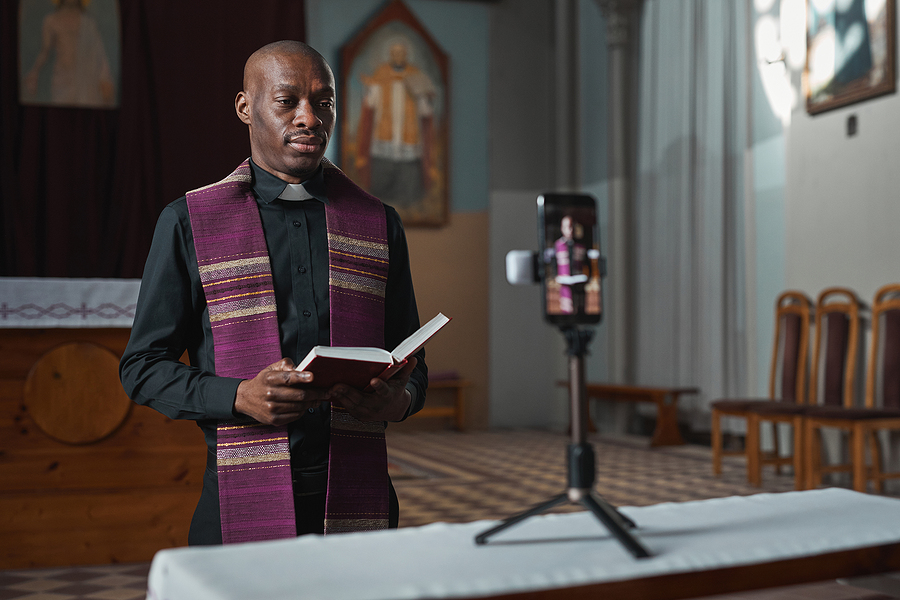
Do Small Churches Need to Embrace Technology?
Do small churches need to embrace technology? If so, how much? With the whole world moving online, small churches shouldn’t be left behind. But many small churches are rural congregations with aging members. How do you help them make the leap?
In this article I am going to share the top three ways your small church can embrace technology. Your congregation is important to your community, and your message is more relevant than ever before. Embracing technology, without breaking the bank, or overloading your people, is important.
Small Church Technology: Avoid Too Much Too Fast
As you embrace technology, or add more tech, avoid making this one mistake: doing too much too fast. Small churches tend to be late adopters. They won’t be the first on the technology bandwagon. But they needn’t be the last. Avoid doing too much too fast or you’ll hit a wall of resistance. Instead, start with what is most needed and go from there.
I suggest you start with these three steps for small churches to embrace technology.
Step One: Get Up to Date
The first step in embracing technology is to make sure your basic tech is working and functional. For instance, does your small church have a working phone with an up-to-date phone message? Does the congregation own and use a computer? Is email set up?
I arrived at a small rural congregation in August of 1999 to find that the church was off the grid. The photocopier was on the fritz, the voicemail was disabled, the computer was iffy, and they had no email account.
Within the first month of my tenure, I ensured the basic technology was up and working. By the time December 31, 1999 came around, we were online enough to be worried by the Y2K scare. Several years later, the congregation was gifted a screen and overhead projection system. I was concerned that the older generation wouldn’t like it. But they surprised me: they loved how large the words were; the enhanced visibility made singing louder and easier.
When it comes to technology, start with the basics before you expand. And I mean basics: a telephone, a photocopier, a computer, and an email account are basic. For many congregations the basics also include an overhead projection system. Of course, if you don’t have indoor plumbing or electricity, you might want to start there!
Step Two: Get Connected to the Outside World
The second step in embracing technology is to get connected to the outside world. After you’ve got the basics, expand to include a Facebook page, or a website. If you don’t have your own website, make sure your congregation is noted on regional or denominational websites with correct worship times and days, address, and pastor or congregational leader.
By the time I left the rural congregation I served, some seven years later, the congregation also had a working website. Although Facebook didn’t exist at the time, when it came into being, I’m hopeful someone saw to it that a Facebook page was established.

Step Three: Hybrid Worship
Make the move to bring your worship online. You can do it with Facebook Live. That’s as simple as using a smartphone to capture what happens in worship. When you do this, be sure to address the people who are watching, worshiping, and participating with you online. Even if they watch later, they are still part of your congregation. Be sure to greet them. Include them in the message, the prayers, and the offering. Likely you’ll find your worship growing as you expand the ways people can participate.
Small Church Technology Do’s and Don’ts
Do make progress. You can go farther than you think you can. By incorporating technology and the accepting the learning curve that comes with it, you may be surprised how quickly you learn how to use the tools that are most helpful and necessary for your congregation.
Don’t assume that older people don’t want to embrace technology. Many of them are meeting with kids and grandkids on weekly Zoom meetings, FaceTime visits, and the like. Also, don’t assume that every young person is constantly on their smartphone, or even has a smartphone.
Do use the technology you invest in for multiple purposes. A webcam is a great tool that can be used to record, livestream, or take worship to Zoom. This will allow greater participation for members that aren’t comfortable returning to church or can’t attend in person every week.
Don’t make tech decisions based solely on cost. Money that goes toward getting or upgrading outdated technology is money well spent. The benefits of buying quality equipment that will allow you to reach a larger community is unmatched.
Think of embracing technology as a journey, not an event. Technology isn’t going away. You can’t master it. None of us can. But you also don’t have to resist the flow of it.
When it comes to technology, the point isn’t to be trendy. Rather it’s to be connected in all the ways that are possible. Just as the Bible reminds us that even feet can be beautiful as they carry the good news, so too can new technologies. They enable us to carry good news in fresh ways.
Not sure how to handle the technology reformation or other ways of moving people forward? Reach out here to stay connected. You don’t have to do it alone.
Copyright © 2021 rebekahsimonpeter.com, All Rights Reserved.


